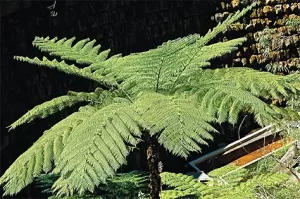BY LACHLAN TURNER
The (Lacy) Tree Ferns (Cyathea cooperi) is the more spectacular of these two related species – the other being (Rough) Tree Fern (Cyathea australis). Both prefer a moist, high humidity, well-drained habitat with adequate protection from sunlight, which will ensure the fern’s longevity as a spectacular feature plant.

Propagation, although desirable, is not an easy task as these ferns do not produce any new plants from the roots or trunk. They can only be reproduced by the function of germinating spore material, usually from different specimens. Both have a fairly extensive shallow, fibrous rhizome type of root system. These ferns can suffer under drought conditions and require a daily drink in these circumstances.
Both varieties share a similar distribution from the Central Queensland Coast to Southern Victoria. Cyathea australis is more prolific as it tolerates cooler climates better and is more likely to be found in mountain areas as well as in Tasmania. Both varieties can quickly reach a height in excess of 6m where habitat conditions are most favourable.

When walking along tracks that follow watercourses and passing by large ponds of still water, these majestic ferns growing along the water’s edge are conspicuous as they create a somewhat impressive rainforest-like vista, particularly when the fronds are reflected on the still waters of the pond.




